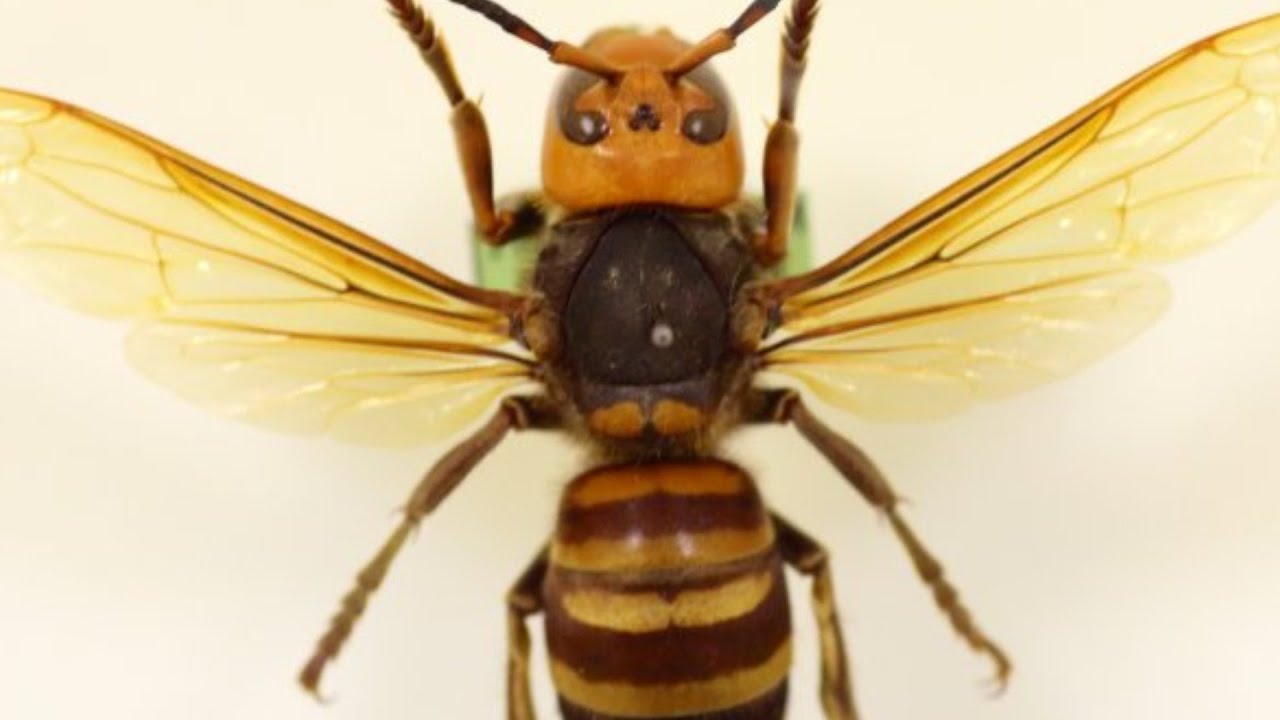Everything You Need To Know About ‘Murder Hornets’

You might have noticed the recent “buzz” about a certain, particularly worrying insect that goes by the charming nickname “murder hornet.”
These unsavory creatures were first spotted in the United States in December 2019, and unfortunately, the nickname is not just a hyperbolic, wacky pro wrestler moniker.
The hornet we’re talking about is Vespa mandarinia. This monstrosity can grow up to two inches long, and bee breeder Susan Cobey of Washington State University’s Department of Entomology describes them as, quote, “like something out of a monster cartoon, with this huge yellow-orange face.”
There have been four verified sightings of the Asian giant hornet in Washington state, and a further two in Canada’s British Columbia. Luckily, Rian Wojahn of Washington State’s Department of Agriculture has told Time that officials are addressing the situation with “an aggressive outreach and trapping campaign.” So, hopefully, our near future doesn’t include too many murder hornet swarms. Still, it’s probably a good idea to bone up on these things, just in case. Here’s everything you need to know about the frighteningly-named murder hornets.
If you see an Asian giant hornet, we have good news and bad news. The good news is that they don’t seem to actively target humans. However, the bad news is that if they do decide to sting you, you’re in for a world of pain. Even beekeeper suits can’t stop their stings, which are Bad with a capital B.
Conrad Bérubé, a beekeeper who was stung around seven times while getting rid of a nest, described the sensation to The New York Times as the most painful sting he’s ever experienced, and he’s been stung a lot. The sting is said to feel a bit like hot metal being injected into your body.
Oh, and of course the murder hornet’s sting is potentially lethal, though that can be said of any sort of hornet venom in sufficient volume. This particular venom includes a heaping helping of neurotoxins, and while one sting won’t end your life, enough of them might. Furthermore, these being hornets, they’re able to sting multiple times without dying. This is not a theoretical scenario, either. Reportedly, murder hornets kill as many as 50 people in Japan every year. Keep watching the video to see everything you need to know about ‘murder hornets’!
How can individuals protect themselves from the potentially lethal stings of Murder Hornets, and what should they do if they encounter these insects?
Murder Hornets, also known as the Asian giant hornet, have recently become a topic of concern and fear among people in North America. These insects are notorious for their aggressive behavior and powerful sting, which has led to the deaths of dozens of people in Asia. But what exactly are Murder Hornets, and how do they pose a threat to humans and the environment?
Murder Hornets are a large species of hornet native to Asia, particularly Japan, China, and South Korea. They are also found in some parts of Russia and Nepal. They are the largest hornet species in the world, with queens growing up to 2 inches in length and workers up to 1.5 inches.
Their name is derived from their predatory behavior, as they are known to attack and decimate entire colonies of honeybees, which can have devastating effects on bee populations and crop pollination. These hornets can kill up to 40 honeybees per minute, and a single hornet can kill a colony of thousands in just a few hours.
But what sets Murder Hornets apart from other hornet and wasp species is their potent venom and aggressive temperament. Their sting is described as feeling like hot metal piercing the skin, and their venom contains a neurotoxin that can cause severe pain, swelling, and even multiple organ failure in some cases. Multiple stings can lead to death, especially in people with allergies or respiratory conditions.
Murder Hornets are not typically aggressive towards humans unless provoked or agitated, but they can cause significant harm to pets and children who may encounter them by accident. Their stings can also damage nearby fruits and vegetables, affecting agricultural production.
The recent sightings of Murder Hornets in North America, particularly in Washington state, have raised concerns about their impact on local ecosystems and the risks they pose to humans. It is believed that these hornets were accidentally introduced to the region through international shipping and cargo, and there are fears that they may spread to other parts of the country.
Efforts are underway to contain and eradicate the Murder Hornet population in the US, but it may take time and resources to effectively control their spread. Experts urge people to be cautious and avoid contact with these insects, and to report any sightings to local authorities.
In conclusion, Murder Hornets are a formidable insect species that pose a threat to bees, agriculture, and potentially humans. While they may not be present in all parts of the world, it is essential to be aware of their behavior and take precautions to avoid encounters with them. Further research and conservation efforts are necessary to prevent their further spread and protect ecosystems and biodiversity.










3 Years Living In A $1900 Renovated RV – Her DIY Mods & Lessons Learned
The Man Behind the Most Grueling Footrace on Earth
Living a Radically Simple Permaculture Life on 1/4 Acre
The Secret Infrastructure Beneath NYC
Bare-handed shark fishing